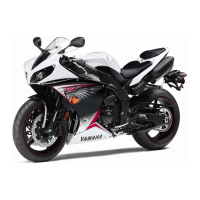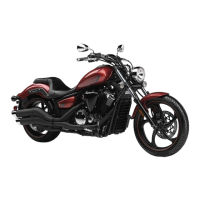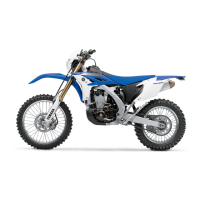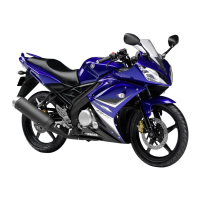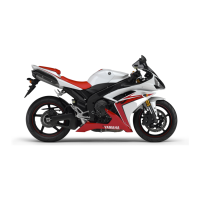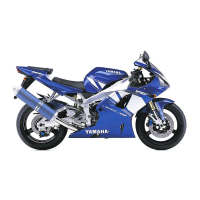Do you have a question about the Yamaha YZF-R1B 2012 and is the answer not in the manual?
Locating vehicle identification number and model label for spare parts.
Overview of the Fuel Injection (FI) system, YCC-T, YCC-I, and Traction Control System (TCS).
Guidance on preparation for disassembly, replacement parts, and handling of electronic components.
List of specialized tools required for maintenance and assembly, including part numbers.
Vehicle dimensions, weight, maximum load, and model identification for various regions.
Detailed technical data for engine type, displacement, fuel, oil, lubrication, cooling system, and components.
Specifications for frame, wheels, tires, brakes, suspension, swingarm, and drive chain.
Specifications for voltage, ignition system, engine control unit, battery, lighting, indicators, and fuses.
Specifications for tightening torques of various engine and chassis fasteners, with general guidelines.
Lists lubrication points and recommended lubricants for engine and chassis components.
Illustrates the engine oil lubrication system flow with numbered components.
Diagrams illustrating the coolant flow through the radiator, hoses, and engine components.
Diagrams and instructions for routing electrical wires and cables on the motorcycle.
Chart detailing scheduled maintenance tasks based on odometer readings and annual checks.
Overview of routine maintenance and lubrication tasks with their recommended intervals.
Procedure to inspect fuel hoses for damage, cracks, or loose connections.
Steps for inspecting, cleaning, and adjusting spark plugs for optimal engine performance.
Detailed procedure for measuring and adjusting valve clearance on a cold engine.
Procedure for synchronizing throttle bodies using vacuum gauges for optimal engine response.
Inspection of throttle body joints for any cracks or damage.
Inspection of the crankcase breather hose for damage, cracks, or loose connections.
Inspection of exhaust pipes, chambers, mufflers, and gaskets for damage or leaks.
Procedure to adjust exhaust gas volume via the diagnostic mode for emissions control.
Reference to the detailed check of the air induction system found elsewhere in the manual.
Step-by-step guide for replacing the air filter element, including necessary precautions.
Procedure for checking and adjusting clutch cable free play at the handlebar and engine.
Procedure to verify the proper functioning of both front and rear brake systems.
Method for checking brake fluid level, adding recommended fluid, and safety warnings.
Procedure for adjusting the front brake lever position for optimal reach and feel.
Inspection of front brake pad wear and replacement guidelines when indicators are reached.
Procedure for checking and adjusting the rear brake pedal position for rider comfort.
Inspection of rear brake pad wear and replacement guidelines when indicators are reached.
Comprehensive procedure for bleeding air from the hydraulic brake system to restore proper function.
Inspection of front brake hoses and clamps for any signs of damage, wear, or looseness.
Inspection of rear brake hose and clamp for any signs of damage, wear, or looseness.
Inspection of wheels for damage or out-of-round conditions that may require replacement.
Procedure for checking tire surfaces, tread depth, wear indicators, and tire pressure.
Procedure for checking wheel bearings for looseness or damage.
Procedure to check swingarm operation and for excessive play.
Procedure for measuring and adjusting drive chain slack, emphasizing correct tension.
Guidance on cleaning and lubricating the drive chain, specifying recommended lubricants.
Procedure for checking steering head for binding or looseness and adjusting it.
Reference to the detailed procedure for checking the steering damper's functionality.
Instruction to ensure all chassis fasteners are properly tightened.
Lubrication of critical pivot points for smooth brake lever operation.
Lubrication of critical pivot points for smooth clutch lever operation.
Lubrication of critical pivot points for smooth pedal operation.
Procedure for adjusting the shift pedal position by modifying the shift rod length.
Procedure to check the sidestand for proper operation.
Lubrication of the sidestand's pivoting point and moving parts.
Reference to checking the sidestand switch within the Electrical Components section.
Inspection of front fork legs for damage, leaks, and proper operation of suspension.
Procedure for adjusting spring preload and damping settings on front fork legs.
Reference to checking the rear shock absorber assembly's condition and function.
Procedure for adjusting spring preload and damping settings on the rear shock absorber.
Reference to checking the connecting arm and relay arm components.
Procedure for checking engine oil level, ensuring it is between minimum and maximum marks.
Method for measuring engine oil pressure, including diagnostic steps for low pressure.
Step-by-step guide for draining engine oil and replacing the oil filter cartridge.
Procedure for checking coolant level, with handling precautions.
Inspection of cooling system components like radiator, hoses, and water pump for damage.
Procedure for draining and refilling the cooling system with the correct coolant mixture.
Reference to checking the front brake light switch within the Electrical Components section.
Procedure for adjusting the rear brake light switch for correct activation timing.
Inspection of control cables for damage and lubrication of sheaths.
Procedure for checking and adjusting throttle cable free play.
Lubrication of the rear suspension's pivot points and moving parts.
Procedure for checking battery charge state and proper charging methods.
Procedure for checking fuses for continuity and replacing blown fuses.
Step-by-step instructions for replacing headlight bulbs, including safety precautions.
Procedure for adjusting headlight beams vertically and horizontally.
Procedures for removing and installing seats, cowlings, ECU, air ducts, mirrors, and windshield.
Detailed procedures for removing, disassembling, checking, and installing the front wheel assembly.
Detailed procedures for removing, disassembling, checking, and installing the rear wheel assembly.
Comprehensive procedures for servicing front brake components including pads, calipers, and master cylinder.
Comprehensive procedures for servicing rear brake components including pads, caliper, and master cylinder.
Procedures for removing, checking, and installing handlebars, grips, switches, and control levers.
Detailed procedures for removing, disassembling, checking, and assembling the front fork legs.
Procedures for removing, checking, and installing steering head components, including bearings.
Procedures for handling, removing, and checking the rear shock absorber assembly.
Procedures for removing, checking, and installing the swingarm, including pivot shaft and drive chain.
Procedures for removing, checking, cleaning, lubricating, and installing the drive chain and sprockets.
Procedures for inspecting the engine, including compression pressure and valve clearance.
Detailed steps for removing the engine assembly, including exhaust, fairings, and disconnecting systems.
Procedures for removing, checking, and installing camshafts, timing chain, and related components.
Procedures for removing, checking, and installing the cylinder head, gasket, and fasteners.
Procedures for removing, checking, and installing valves, springs, seals, and guides.
Procedures for removing and installing the generator cover, rotor, and stator coil assembly.
Procedures for removing, checking, and installing the starter clutch assembly and related gears.
Procedures for removing and installing the pickup rotor and its cover.
Procedures for removing, disassembling, checking, and assembling the starter motor.
Procedures for removing the oil pan, oil/water pump assembly, and disassembling the oil pump.
Procedures for removing, checking, and installing clutch components like plates, springs, and housing.
Procedures for removing, checking, and installing the shift shaft and stopper lever.
Procedures for separating, checking, assembling, and tightening crankcase halves and bolts.
Procedures for removing, checking, and installing connecting rods and pistons, including clearance measurements.
Procedures for removing, checking, and installing the crankshaft and balancer shaft, including bearing selection.
Procedures for removing, disassembling, checking, and installing the transmission, shift drum, and forks.
Procedures for removing, checking, and installing the radiator, hoses, and fan.
Procedures for removing and installing the oil cooler, including checking hoses and union bolt.
Procedure for checking thermostat operation and assembling/installing the thermostat housing.
Procedures for disassembling, checking, and assembling the water pump, including seals and impeller.
Procedures for removing and installing the fuel tank, fuel pump, and side covers.
Procedures for removing and installing the air filter case, secondary injectors, and intake funnel assembly.
Procedures for removing, checking, cleaning, and synchronizing throttle bodies and sensors.
Explanation of the air induction system and procedures for checking hoses, reed valves, and air cut-off valve.
Circuit diagram, troubleshooting for engine stopping, and ignition system components.
Circuit diagram and troubleshooting for the electric starting system, including starter motor and relays.
Circuit diagram and troubleshooting for the charging system, including battery, stator, and rectifier.
Circuit diagram and troubleshooting for headlights, signals, and indicator lights.
Circuit diagram and troubleshooting for turn signals, brake lights, hazard lights, horn, and warning lights.
Circuit diagram and troubleshooting for cooling system components like radiator fan and coolant sensor.
Circuit diagram, ECU self-diagnostics, fault codes, and troubleshooting for the fuel injection system.
Circuit diagram and troubleshooting for the fuel pump system, including fuses, relays, and pump checks.
Circuit diagram, general info, part replacement, key registration, and troubleshooting for the immobilizer system.
Diagrams illustrating the location of key electrical components on the motorcycle.
General notes on troubleshooting procedures and referring to relevant manual sections.
Common causes and checks for engine starting failures, categorized by system.
Potential causes for incorrect engine idling speed, including engine, fuel, and throttle body issues.
Troubleshooting steps for poor engine performance at medium and high speeds.
Possible causes and checks for difficult gear shifting.
Troubleshooting steps for a non-moving shift pedal, related to shift shaft and drum.
Possible causes for the transmission jumping out of gear.
Troubleshooting for clutch slip or drag issues, covering clutch components and engine oil.
Potential causes for engine overheating, related to cooling system and engine oil.
Possible causes for engine overcooling, primarily related to thermostat operation.
Troubleshooting steps for poor brake performance, covering pads, discs, fluid, and caliper issues.
Troubleshooting for faulty front fork legs, including oil leaks and damping issues.
Causes of unstable motorcycle handling, related to handlebars, steering head, fork, swingarm, and rear suspension.
Troubleshooting for issues with headlights, turn signals, brake lights, horn, and indicator lights.
Locating vehicle identification number and model label for spare parts.
Overview of the Fuel Injection (FI) system, YCC-T, YCC-I, and Traction Control System (TCS).
Guidance on preparation for disassembly, replacement parts, and handling of electronic components.
List of specialized tools required for maintenance and assembly, including part numbers.
Vehicle dimensions, weight, maximum load, and model identification for various regions.
Detailed technical data for engine type, displacement, fuel, oil, lubrication, cooling system, and components.
Specifications for frame, wheels, tires, brakes, suspension, swingarm, and drive chain.
Specifications for voltage, ignition system, engine control unit, battery, lighting, indicators, and fuses.
Specifications for tightening torques of various engine and chassis fasteners, with general guidelines.
Lists lubrication points and recommended lubricants for engine and chassis components.
Illustrates the engine oil lubrication system flow with numbered components.
Diagrams illustrating the coolant flow through the radiator, hoses, and engine components.
Diagrams and instructions for routing electrical wires and cables on the motorcycle.
Chart detailing scheduled maintenance tasks based on odometer readings and annual checks.
Overview of routine maintenance and lubrication tasks with their recommended intervals.
Procedure to inspect fuel hoses for damage, cracks, or loose connections.
Steps for inspecting, cleaning, and adjusting spark plugs for optimal engine performance.
Detailed procedure for measuring and adjusting valve clearance on a cold engine.
Procedure for synchronizing throttle bodies using vacuum gauges for optimal engine response.
Inspection of throttle body joints for any cracks or damage.
Inspection of the crankcase breather hose for damage, cracks, or loose connections.
Inspection of exhaust pipes, chambers, mufflers, and gaskets for damage or leaks.
Procedure to adjust exhaust gas volume via the diagnostic mode for emissions control.
Reference to the detailed check of the air induction system found elsewhere in the manual.
Step-by-step guide for replacing the air filter element, including necessary precautions.
Procedure for checking and adjusting clutch cable free play at the handlebar and engine.
Procedure to verify the proper functioning of both front and rear brake systems.
Method for checking brake fluid level, adding recommended fluid, and safety warnings.
Procedure for adjusting the front brake lever position for optimal reach and feel.
Inspection of front brake pad wear and replacement guidelines when indicators are reached.
Procedure for checking and adjusting the rear brake pedal position for rider comfort.
Inspection of rear brake pad wear and replacement guidelines when indicators are reached.
Comprehensive procedure for bleeding air from the hydraulic brake system to restore proper function.
Inspection of front brake hoses and clamps for any signs of damage, wear, or looseness.
Inspection of rear brake hose and clamp for any signs of damage, wear, or looseness.
Inspection of wheels for damage or out-of-round conditions that may require replacement.
Procedure for checking tire surfaces, tread depth, wear indicators, and tire pressure.
Procedure for checking wheel bearings for looseness or damage.
Procedure to check swingarm operation and for excessive play.
Procedure for measuring and adjusting drive chain slack, emphasizing correct tension.
Guidance on cleaning and lubricating the drive chain, specifying recommended lubricants.
Procedure for checking steering head for binding or looseness and adjusting it.
Reference to the detailed procedure for checking the steering damper's functionality.
Instruction to ensure all chassis fasteners are properly tightened.
Lubrication of critical pivot points for smooth brake lever operation.
Lubrication of critical pivot points for smooth clutch lever operation.
Lubrication of critical pivot points for smooth pedal operation.
Procedure for adjusting the shift pedal position by modifying the shift rod length.
Procedure to check the sidestand for proper operation.
Lubrication of the sidestand's pivoting point and moving parts.
Reference to checking the sidestand switch within the Electrical Components section.
Inspection of front fork legs for damage, leaks, and proper operation of suspension.
Procedure for adjusting spring preload and damping settings on front fork legs.
Reference to checking the rear shock absorber assembly's condition and function.
Procedure for adjusting spring preload and damping settings on the rear shock absorber.
Reference to checking the connecting arm and relay arm components.
Procedure for checking engine oil level, ensuring it is between minimum and maximum marks.
Method for measuring engine oil pressure, including diagnostic steps for low pressure.
Step-by-step guide for draining engine oil and replacing the oil filter cartridge.
Procedure for checking coolant level, with handling precautions.
Inspection of cooling system components like radiator, hoses, and water pump for damage.
Procedure for draining and refilling the cooling system with the correct coolant mixture.
Reference to checking the front brake light switch within the Electrical Components section.
Procedure for adjusting the rear brake light switch for correct activation timing.
Inspection of control cables for damage and lubrication of sheaths.
Procedure for checking and adjusting throttle cable free play.
Lubrication of the rear suspension's pivot points and moving parts.
Procedure for checking battery charge state and proper charging methods.
Procedure for checking fuses for continuity and replacing blown fuses.
Step-by-step instructions for replacing headlight bulbs, including safety precautions.
Procedure for adjusting headlight beams vertically and horizontally.
Procedures for removing and installing seats, cowlings, ECU, air ducts, mirrors, and windshield.
Detailed procedures for removing, disassembling, checking, and installing the front wheel assembly.
Detailed procedures for removing, disassembling, checking, and installing the rear wheel assembly.
Comprehensive procedures for servicing front brake components including pads, calipers, and master cylinder.
Comprehensive procedures for servicing rear brake components including pads, caliper, and master cylinder.
Procedures for removing, checking, and installing handlebars, grips, switches, and control levers.
Detailed procedures for removing, disassembling, checking, and assembling the front fork legs.
Procedures for removing, checking, and installing steering head components, including bearings.
Procedures for handling, removing, and checking the rear shock absorber assembly.
Procedures for removing, checking, and installing the swingarm, including pivot shaft and drive chain.
Procedures for removing, checking, cleaning, lubricating, and installing the drive chain and sprockets.
Procedures for inspecting the engine, including compression pressure and valve clearance.
Detailed steps for removing the engine assembly, including exhaust, fairings, and disconnecting systems.
Procedures for removing, checking, and installing camshafts, timing chain, and related components.
Procedures for removing, checking, and installing the cylinder head, gasket, and fasteners.
Procedures for removing, checking, and installing valves, springs, seals, and guides.
Procedures for removing and installing the generator cover, rotor, and stator coil assembly.
Procedures for removing, checking, and installing the starter clutch assembly and related gears.
Procedures for removing and installing the pickup rotor and its cover.
Procedures for removing, disassembling, checking, and assembling the starter motor.
Procedures for removing the oil pan, oil/water pump assembly, and disassembling the oil pump.
Procedures for removing, checking, and installing clutch components like plates, springs, and housing.
Procedures for removing, checking, and installing the shift shaft and stopper lever.
Procedures for separating, checking, assembling, and tightening crankcase halves and bolts.
Procedures for removing, checking, and installing connecting rods and pistons, including clearance measurements.
Procedures for removing, checking, and installing the crankshaft and balancer shaft, including bearing selection.
Procedures for removing, disassembling, checking, and installing the transmission, shift drum, and forks.
Procedures for removing, checking, and installing the radiator, hoses, and fan.
Procedures for removing and installing the oil cooler, including checking hoses and union bolt.
Procedure for checking thermostat operation and assembling/installing the thermostat housing.
Procedures for disassembling, checking, and assembling the water pump, including seals and impeller.
Procedures for removing and installing the fuel tank, fuel pump, and side covers.
Procedures for removing and installing the air filter case, secondary injectors, and intake funnel assembly.
Procedures for removing, checking, cleaning, and synchronizing throttle bodies and sensors.
Explanation of the air induction system and procedures for checking hoses, reed valves, and air cut-off valve.
Circuit diagram, troubleshooting for engine stopping, and ignition system components.
Circuit diagram and troubleshooting for the electric starting system, including starter motor and relays.
Circuit diagram and troubleshooting for the charging system, including battery, stator, and rectifier.
Circuit diagram and troubleshooting for headlights, signals, and indicator lights.
Circuit diagram and troubleshooting for turn signals, brake lights, hazard lights, horn, and warning lights.
Circuit diagram and troubleshooting for cooling system components like radiator fan and coolant sensor.
Circuit diagram, ECU self-diagnostics, fault codes, and troubleshooting for the fuel injection system.
Circuit diagram and troubleshooting for the fuel pump system, including fuses, relays, and pump checks.
Circuit diagram, general info, part replacement, key registration, and troubleshooting for the immobilizer system.
Diagrams illustrating the location of key electrical components on the motorcycle.
General notes on troubleshooting procedures and referring to relevant manual sections.
Common causes and checks for engine starting failures, categorized by system.
Potential causes for incorrect engine idling speed, including engine, fuel, and throttle body issues.
Troubleshooting steps for poor engine performance at medium and high speeds.
Possible causes and checks for difficult gear shifting.
Troubleshooting steps for a non-moving shift pedal, related to shift shaft and drum.
Possible causes for the transmission jumping out of gear.
Troubleshooting for clutch slip or drag issues, covering clutch components and engine oil.
Potential causes for engine overheating, related to cooling system and engine oil.
Possible causes for engine overcooling, primarily related to thermostat operation.
Troubleshooting steps for poor brake performance, covering pads, discs, fluid, and caliper issues.
Troubleshooting for faulty front fork legs, including oil leaks and damping issues.
Causes of unstable motorcycle handling, related to handlebars, steering head, fork, swingarm, and rear suspension.
Troubleshooting for issues with headlights, turn signals, brake lights, horn, and indicator lights.
| Displacement | 998 cc |
|---|---|
| Compression Ratio | 12.7:1 |
| Transmission | 6-speed |
| Final Drive | Chain |
| Frame | Aluminum Deltabox |
| Front Suspension | 43 mm inverted fork, fully adjustable |
| Front Tire | 120/70 ZR17 |
| Rear Tire | 190/55 ZR17 |
| Engine Type | Liquid-cooled, 4-stroke, DOHC, inline 4-cylinder |
| Bore x Stroke | 78.0mm x 52.2mm |
| Max Power | 182 hp (134.2 kW) @ 12, 500 rpm |
| Max Torque | 83.6 lb-ft (112.4 Nm) @ 10, 000 rpm |
| Fuel System | Fuel Injection |
| Ignition | TCI |
| Rear Suspension | Single shock, fully adjustable |
| Rear Brake | 220mm disc, single-piston caliper |
| Fuel Capacity | 4.8 gallons |
| Wet Weight | 206 kg |
| Width | 28.1 in |
| Wheelbase | 55.7 in |
| Ground Clearance | 5.3 in (135 mm) |
| Seat Height | 32.8 in |

